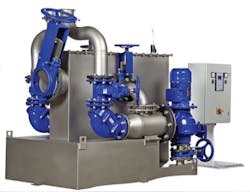Sufficient NPSH Margin Important to Pump Reliability
By Allan R. Budris
Past columns have touched on pump Net Positive Suction Head Required (NPSHR) and Net Positive Suction Head Available (NPSHA,) and how the relationship between the two can impact pump reliability. However, this issue has not been covered in detail to this point. This column is intended to further elaborate on this phenomena. It will address some of the typical questions such as: What exactly is pump NPSHR? Is it the start of cavitation in a pump? Does it designate the amount of suction pressure required to the pump for reliable service? How is it measured?
Cavitation
Cavitation is the change in state of the pumped liquid from a liquid to a vapor, due to a drop in the local static pressure below the vapor pressure of the liquid. This vapor, in sufficient volume, will eventually restrict the flow of liquid through the impeller eye, which also reduces the pump's head generation. When the energy level at the inlet to the pump impeller (Suction Energy, see October 2007 column) is high enough, the condensation (subsequent implosion) of this vapor on the metal surfaces within the impeller can cause noise and erosion of the metal flow surfaces. This occurs as the local static pressure increases above the vapor pressure further into the impeller, usually on the impeller vanes. With very high suction energy values, this cavitation damage can erode away the inlet vanes of the impeller within a matter of months, or less.
NPSH is an absolute term, meaning it is a measure of the absolute total pressure (above atmospheric pressure) and includes the velocity head. It is also measured above the vapor pressure of the liquid. The equation for the NPSH Available, given in feet of liquid, is:
NPSHR
The Hydraulic Institute has established the industry standard for the "NPSHR" of a pump, and it is the NPSHA at a given flow rate and speed, which will create enough cavitation in the suction of a pump impeller to drop the developed head by 3% (see figures 1). The NPSHR can also be determined by holding the NPSHA constant and increasing the pump flow rate until the 3% head drop is achieved, as shown in figure 2. The NPSHR of a pump is not the start of cavitation, or when damage begins in a pump. It can take a NPSHA of from 2 to 20 times the NPSHR of a pump to suppress all cavitation in the suction of a pump, with the average (for flow rates above suction recirculation) being around 4 times the NPSHR.
NPSH Margin
The NPSH Margin is the amount that the NPSH Available to the pump exceeds the NPSHR of the pump, see figure 3. As discussed above, some NPSH Margin is required just to achieve the full published (0% drop) head of a pump. It can take a NPSH Margin ratio (NPSHA/NPSHR) of about 1.3 to 1.7 just to achieve this 100% rated head value. Much higher NPSH Margins are required in High Suction Energy pumps when the pump is at low flow rates in the suction recirculation region. The suction energy determines how much margin is required. In a prior standard, the Hydraulic Institute recommended the following minimum NPSH Margin ratio values for the three Suction Energy levels (Low, High and Very High), above the start of suction recirculation, and these are shown in Table 1.
NPSH Margin Impact on Pump Reliability
Based on field data from two industrial plants (one having primarily end suction pumps and the other with axial flow split case pumps), the writer found a definite correlation between the reliability of a centrifugal pump and the NPSH Margin, as shown in figure 4. As can be seen, the reliability doubles from a NPSH Margin Ratio of 1.0 to a NPSH Margin Ratio of 4.0 (where the average pump has little or no cavitation). Cavitation in a pump not only affects the impeller surfaces, but the pressure pulsations caused by the collapse of the cavitation bubbles can also damage the bearings and seals.
Also, as the cavitation bubbles are formed in a pump, dissolved air comes out of solution and becomes entrained. This additional entrained air has the capability of causing damage to the mechanical seal faces, due to dry running. Further, if the amount of cavitation differs from one side of a double suction, split case impeller inlet to the other (due to a wrongly placed elbow at the suction), it can greatly increase the axial thrust on the bearings, and reduce their life.
The correlation between the NPSH Margin Ratio and pump reliability is further confirmed by recent field tests, which measured the pressure pulsation in a high suction energy sewage lift pump, as shown in figure 5. This pump experienced high vibration and cavitation damage to the impeller surface after 1,000 hours of operation at lower NPSH margins.
How to Increase the NPSH Margin to a Pump
Even though the options to increase the NPSH Margin to a pump are generally limited in an existing installation, there are still some choices available. These actions, which are spelled out below, mainly involve lowering the NPSHR of the pump.
- Increase the liquid level in the suction vessel.
- Eliminate any flow restrictions in the suction piping (such as a strainer)
- Operate at a flow rate less than the pump bep (see figure 3).
- Install an Inducer, if available
- Change to a low NPSHR impeller, if available
- Operate the pump at a slower speed (if driven by a VFD), or install a VFD.
- Install a new pump (possibly operating at a slower speed) with a lower NPSHR.
Note:
Caution should be taken with any new lower NPSHR pump or low NPSHR impeller, that it will not substantially increase the pump suction energy and result in an overall reduction in the pump reliability. This can happen if the lower NPSHR is achieved by an increase in the impeller eye diameter.
Conclusion
As can be seen above, pump cavitation and NPSH Margin are complex issues, which can have a marked impact on the reliability and MTBF of a pump, and that generally speaking, the higher the NPSH Margin the better the pump reliability (especially with High and Very High Suction Energy pumps, and pump operation in the Suction Recirculation low flow region).
About the Author: Allan R. Budris, P.E., is an independent consulting engineer who specializes in training, failure analysis, troubleshooting, reliability, efficiency audits and litigation support on pumps and pumping systems. With offices in Washington, NJ, he can be contacted via e-mail at [email protected].
More WaterWorld Archives Issue Articles






